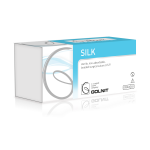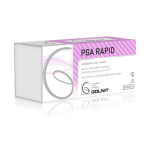POLYESTER sutures
Golnit POLYESTER sutures are sterile surgical braided sutures composed of polyester. The sutures are supplied sterile in various lengths and diameters and attached to a needle with or without pledgets made of PTFE (Teflon).
POLYESTER suture is a nonabsorbable, braided, sterile surgical suture composed of Poly (ethylene terephthalate). It is prepared from fibers of high molecular weight, long-chain, linear polyesters having recurrent aromatic rings as an integral component. The polyester suture is uniformly coated with silicone. The highly adherent coating is a nonreactive nonabsorbable compound which acts as a lubricant to mechanically improve the physical properties of the uncoated suture by improving ease of passage through tissues and by providing overall improved handling qualities as contrasted to the braided, uncoated fiber.
POLYESTER sutures are braided for optimal handling properties, and for good visibility in the surgical field are dyed either green or black. POLYESTER suture is also available in its natural color.
- POLYESTER suture is a nonabsorbable, braided, sterile surgical suture
- POLYESTER suture is available from USP size 8-0 to 6
- POLYESTER suture has a high tensile strength
- Thanks to its inertness and high tensile strength, POLYESTER suture is a popular choice for cardiovascular surgeries
DESCRIPTION
Polyester suture is a nonabsorbable, braided, sterile surgical suture composed of Poly (ethylene terephthalate). It is prepared from fibers of high molecular weight, long-chain, linear polyesters having recurrent aromatic rings as an integral component. The polyester suture is uniformly coated with silicone. The highly adherent coating is a nonreactive nonabsorbable compound which acts as a lubricant to mechanically improve the physical properties of the uncoated suture by improving ease of passage through tissues and by providing overall improved handling qualities as contrasted to the braided, uncoated fiber.
Polyester sutures are braided for optimal handling properties, and for good visibility in the surgical field are dyed either green or black. Polyester suture is also available in its natural color. The suture meets requirements established by the United States Pharmacopoeia (U.S.P.) for nonabsorbable surgical suture.
INDICATIONS
Polyester suture is indicated for use in general soft tissue approximation and/or ligation, including use in cardiovascular, ophthalmic and neurological procedures.
ACTIONS
Polyester suture elicits a minimal acute inflammatory reaction in tissue, which is followed by a gradual encapsulation of the suture by fibrous connective tissue. Implantation studies in animals show no meaningful decline in polyester suture strength over time. Both polyester fiber suture material and the silicon coating are pharmacologically inactive.
CONTRAINDICATIONS
None known.
WARNINGS
Users should be familiar with surgical procedures and techniques involving nonabsorbable sutures before employing polyester suture for wound closure, as risk of wound dehiscence may vary with the site of application and the suture material used.
As with any foreign body, prolonged contact of any suture with salt solutions, such as those found in the urinary or biliary tracts, may result in calculus formation. Acceptable surgical practice should be followed for the management of infected or contaminated wounds.
Do not re-sterilize. Discard opened packages and unused sutures.
PRECAUTIONS
In handling this or any other suture material, care should be taken to avoid damage from handling. Avoid crushing or crimping damage due to application of surgical instruments such as forceps or needle holders.
As with any suture material, adequate knot security requires the accepted surgical technique of flat and square ties with additional throws as warranted by surgical circumstance and the experience of the surgeon. The use of additional throws may be particularly appropriate when knotting monofilaments.
To avoid damaging needle points and swage areas, grasp the needle in an area one-third (1/3) to one-half (1/2) of the distance from the swaged end to the point. Reshaping needles may cause them to lose strength and be less resistant to bending and breaking. Users should exercise caution when handling surgical needles to avoid inadvertent needle sticks. Discard used needles in “sharps” containers.
ADVERSE REACTIONS
Adverse effects associated with the use of this device include wound dehiscence, gradual loss of all tensile strength over time, calculi formation in urinary and biliary tracts when prolonged contact with salt solutions such as urine and bile occurs, infection, minimal acute inflammatory tissue reaction, and transitory local irritation at the wound site. Broken needles may result in extended or additional surgeries or residual foreign bodies. Inadvertent needle sticks with contaminated surgical needles may result in the transmission of blood borne pathogens.
STORAGE
We recommend that the suture shall be stored under at a temperature of between 5 °C and 40 °C and relative humidity not exceeding 80%; the air shall not contain any aggressive admixtures.
PRODUCT PACKAGING
Golnit nonabsorbable sutures are packaged in two-pouch system of inner pouch and outer pouch. Golnit uses medical grade heat-sealable pouches that are for single use only and conform to the international product standards and norms: ISO 11607-1:2006, ISO 11607-2:2006, EN 868-5:2009.
METHODS OF STERILIZATION
Golnit nonabsorbable sutures are sterilized by validated ethylene oxide (EtO) sterilization system
Golnit nonabsorbable sutures are sterilized by validated ethylene oxide (EtO) sterilization system




